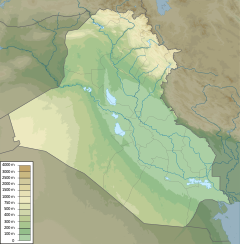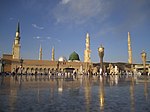Al-Abbas Shrine
| Al-Abbas Shrine | |
|---|---|
Arabic: حَرَم أَبا الْفَضْل الْعَبَّاس | |
 | |
| Religion | |
| Affiliation | Shia Islam |
| Rite | Shia |
| Ecclesiastical or organisational status | Mosque and shrine |
| Status | Active |
| Location | |
| Location | Karbala |
| Country | Iraq |
Location in Iraq | |
| Geographic coordinates | 32°37′1.88″N 44°2′10.38″E / 32.6171889°N 44.0362167°E |
| Architecture | |
| Type | Islamic architecture |
| Specifications | |
| Dome(s) | 1 |
| Minaret(s) | 2 |
The Al-Abbas Shrine (Arabic: حَرَم أَبا الْفَضْل الْعَبَّاس, romanized: Ḥaram ʿAba al-Faḍl al-ʿAbbās) is the mausoleum of Abbas ibn Ali and a mosque, located near the Imam Husayn Mosque in Karbala, Iraq. Abbas was son of Ali ibn Abi Talib and the half-brother of Imam Hasan and Imam Husayn. He was Husayn's flag-bearer in the Battle of Karbala and chief of his caravans. The shrine is revered by the Shia Muslims who visit it every year, especially in the month of Muharram.
Environmental effects over the years have caused the Euphrates river to change course.[1] Nearly 1,400 years after the Battle of Karbala, the river flows across the grave of Abbas and encircles it.[1] It is said that the Euphrates has come to ‘Abbās now.
In recent years[when?] the shrine has undergone a series of enhancements and additions, such as the re-gilding of the dome, and more recently covering the former courtyard with a roof to accommodate pilgrims better. Each year the shrine is visited by millions of pilgrims coming from all over the world.[2]
History and design
[edit]
Emperors and kings of various dynasties have offered valuable gifts and gems to the shrine of Al-Abbas ibn Ali. In 1622, Abbas Shah Safavi ordered the decoration of the grave's dome. He built a window around the grave and organized the precinct.[3]
During the Ottoman era, the shrine was reconstructed by the Ottoman Sultans Suleiman the Magnificent, Murad III, and Murad IV.[4]
The majority of the modern design was done by Persian and Central Asian architects. The central teardrop shaped dome is an ornately decorated structure, with an internal and external dome. The internal dome visible from the inside is ornately decorate with fine mirror work. Two tall minarets stand on the domes sides, and were gilded in gold in the renovation works of 2007. The tomb is covered with pure gold and surrounded by a trellis of silver, along with Iranian carpets rolled out on the floors.[5]
Renovation
[edit]

Beginning in 2012, the Al Abbas mosque has undergone extensive renovations intended to improve the ability of the shrine to accommodate the millions of pilgrims who visit each year. The renovations include rebuilding the wall surrounding the shrine and turning it into a multi-story building housing museums, offices, and additional prayer halls.[6] The dome and minaret have also been re-gilded, and the shrine's courtyard has been covered with a roof.[2]
In 2014, construction began on a basement intended to further accommodate pilgrims. The basement is to be located under the perimeter of the main courtyard and involves systematically closing off parts of the courtyard and then excavating the current court yard. The project is also set to deal with foundational issues of the shrine and reinforce the structure whose foundation has water gaps in it; as part of the Euphrates runs around the grave of Abbas.[7] Once this work is completed, pilgrims will have access for the first time ever to the sardab of Abbas and it will be the closest point to the actual grave. In March 2016, a new Zarih for the grave of Abbas was completed. It is the first Zarih to be fully built in Iraq by Iraqi hands, and was duly inaugurated on the 13th of Rajab the birth of Imam Ali, which coincides with April 21, 2016.
Timeline
[edit]| Year | Event | |
|---|---|---|
| AH | CE | |
| 61 | 680 | October 10: Al-Abbas ibn Ali was buried at this location. |
| 1032 | 1622 | Abbas Shah Safavi decorated the dome of the shrine, built glass encasings around the grave, arranged the porticoes and the yard, constructed the lobby of the first gate of the sanctuary, and sent precious carpets from Iran.[3][8] |
| 1115 | 1703 | Nadir Shah sent gifts to the shrine and had it further decorated.[8] |
| 1117 | 1705 | The vizier of Nadir Shah visited the shrine, reconstructed the porticoes, remade the encasings around the grave, and added a chandelier.[8] |
| 1216 | 1801 | Wahhabis attacked Karbalā, damaged the shrine, and robbed all precious decorative items.[8] |
| 1232 | 1817 | Fat'h ‘Alī Shāh Qājār reconstructed the dome of the shrine, gifted new chandeliers and lustrous pieces of decoration to the holy shrines, and had other constructions carried out.[8] |
| 1355 | 1936 | The custodian of the shrine, Sayyid Murtadhā, rebuilt the silver gate in the golden hallway leading towards the room of the tomb.[8] |
| 1411 | 1991 | March: A violent uprising against the regime of Saddam Hussein occurred in the city, following the Persian Gulf War. |
| 1415 | 1994 | Repairs to the shrine from the damage done in 1991 were finally completed.[9] |
| 1425 | 2004 | March 2: At least 6 explosions[10] occurred during the ‘Āshūrā' commemorations, killing 85 people and wounding 230.[11][12] |
| 1426 | 2006 | January 5: Suicide bombers among the crowd between the two shrines killed at least 60 people and injured more than 100.[13][14] |
| 1428 | 2007 | April 28: A suicide car bomber killed at least 58 people and wounded 170 others as people were heading towards evening prayers.[15][16] |
| 1429 | 2008 | September 11: A bomb was detonated 500m from the shrine which killed one civilian, wounded 3 others, and damaged buildings in the area.[17] |
| 1434 | 2012 | Construction of a roof covering the former courtyard of the shrine began, this comes amidst many efforts by the administration of the Al-Abbas Shrine to accommodate pilgrims better and renovate the shrines.[2] |
| 1436 | 2014 | In late October 2014, the shrine saw the commencement of one of its largest projects ever. The construction of a basement intended to further accommodate pilgrims. the basement is to be located under the perimeter of the main courtyard.[7] |
| 1438 | 2016 | In April 2016, the Zarih, which stands over the grave of Abbas was replaced, the old Zarih had been installed in 1964 under the commission of Sayyed Mohsen Al-Hakim, the new Zarih is the first to be completely built in Iraq and by Iraqi craftsmen[18] |
See also
[edit]- Abbas ibn Ali
- Arba'een
- Holiest sites in Islam (Shia)
- List of the oldest mosques in the world
- Karbala International Airport
References
[edit]- ^ a b KaraÌraviÌ, NajmulhÌ£asan (January 1, 1974). Biography of Hazrat Abbas. Peermahomed Ebrahim Trust. ASIN B0007AIWQW.
- ^ a b c "alkafeel projects". Retrieved 2019-05-29.
- ^ a b History of the Shrines in Karbala
- ^ Karbala in Ottoman archives / Dilek Kaya: p. 94
- ^ Muhammad, Yousaf (December 2001). Al-Abbas (AS) – Rajul Al-Aqidah Wal Jehad. Islamic Republic of Iran.
- ^ "History of the Holy Shrine".
- ^ a b "AlKafeel Global Network".
- ^ a b c d e f at-Tabrizi, Abu Talib (2001). Ahmed Haneef (ed.). Al-Abbas Peace be Upon Him. Abdullah Al-Shahin. Qum: Ansariyan Publications. pp. 75–76.
- ^ Paul Lewis (August 13, 1994). "Karbala Journal; Who Hit the Mosques? Not Us, Baghdad Says". New York Times. Retrieved 15 November 2008.
- ^ "In pictures: Karbala blasts". BBC News. 2 March 2004. Retrieved 15 November 2008.
- ^ "Iraq Shias massacred on holy day". BBC News. 2 March 2004. Archived from the original on 3 December 2008. Retrieved 15 November 2008.
- ^ "Deadly attacks rock Baghdad, Karbala". CNN. March 2, 2004. Retrieved 15 November 2008.
- ^ "Iraq suicide bomb blasts kill 120". BBC News. 5 January 2006. Archived from the original on 19 December 2008. Retrieved 15 November 2008.
- ^ Oppel Jr, Richard A. (January 6, 2006). "Up to 130 Killed in Iraq, Drawing a Shiite Warning". The New York Times. Retrieved 15 November 2008.
- ^ "Car bomb attack near Shiite shrines kills dozens". CNN. April 29, 2007. Retrieved 15 November 2008.
- ^ "Bomb kills many in Iraq holy city". BBC News. 28 April 2007. Retrieved 15 November 2008.
- ^ Jomana Karadsheh (September 11, 2008). "3 killed in Iraq shrine bombings". CNN. Archived from the original on 14 October 2008. Retrieved 15 November 2008.
- ^ "The High Responsible of the Al-Abbas's (P) Holy Shrine authorized the dismantling of the old grid of Aba Al-Fadl Al-Abbas (Peace be upon him)".



